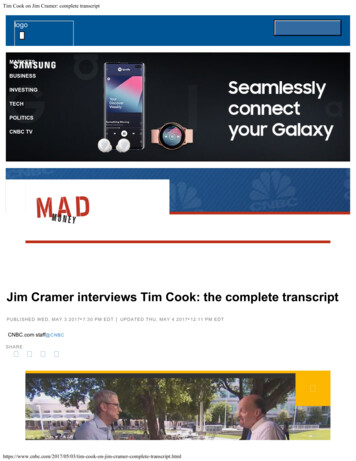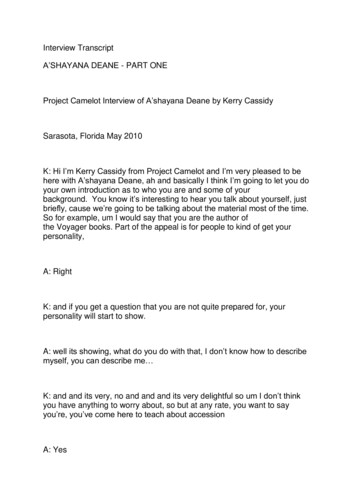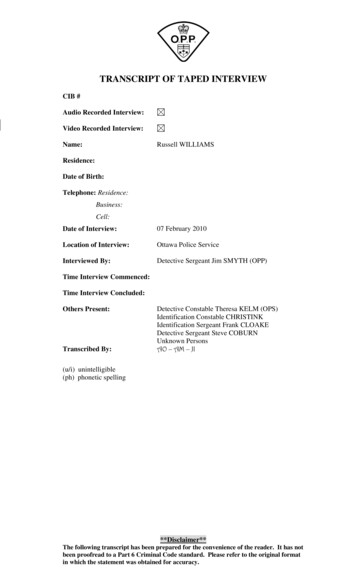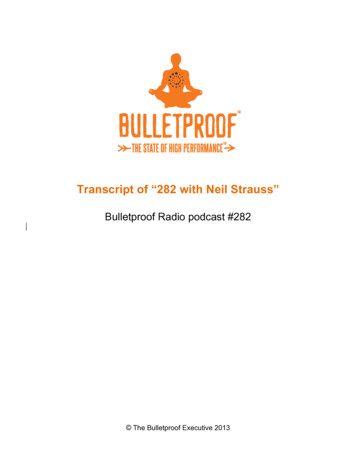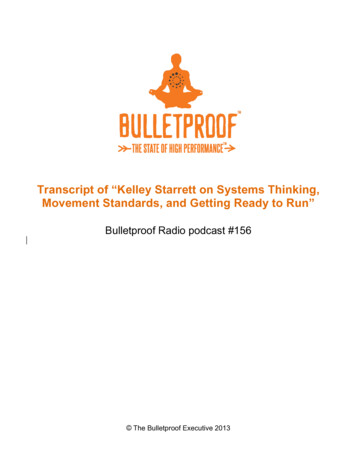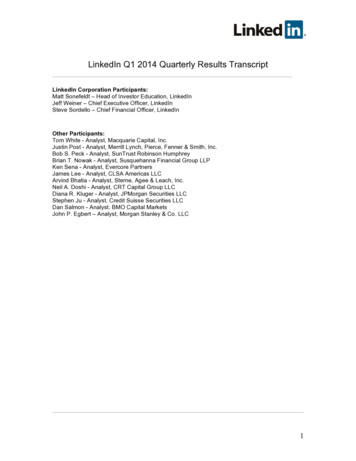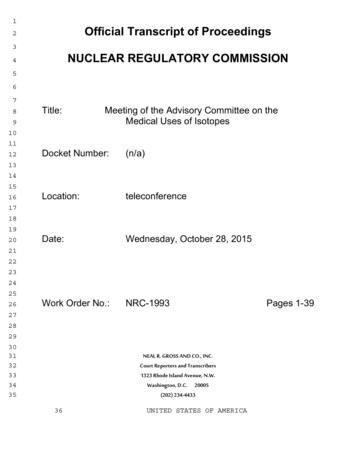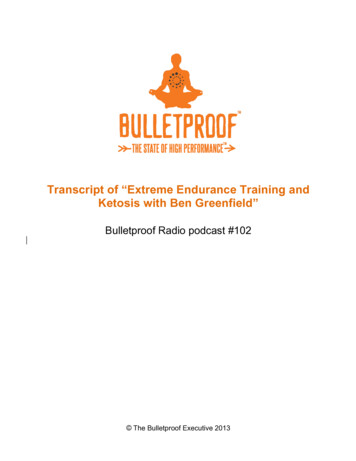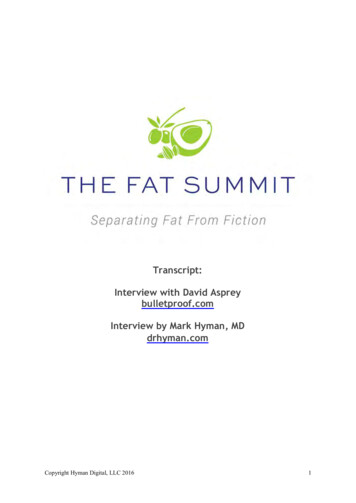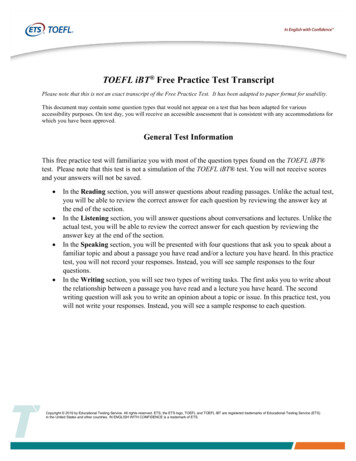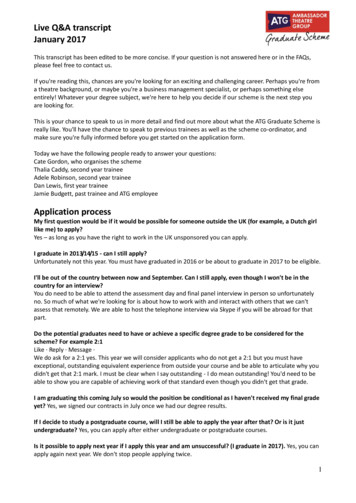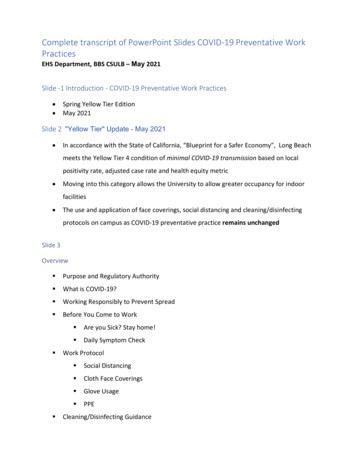
Transcription
Complete transcript of PowerPoint Slides COVID-19 Preventative WorkPracticesEHS Department, BBS CSULB – May 2021Slide -1 Introduction - COVID-19 Preventative Work Practices Spring Yellow Tier EditionMay 2021Slide 2 "Yellow Tier" Update - May 2021 In accordance with the State of California, “Blueprint for a Safer Economy”, Long Beachmeets the Yellow Tier 4 condition of minimal COVID-19 transmission based on localpositivity rate, adjusted case rate and health equity metric Moving into this category allows the University to allow greater occupancy for indoorfacilities The use and application of face coverings, social distancing and cleaning/disinfectingprotocols on campus as COVID-19 preventative practice remains unchangedSlide 3Overview Purpose and Regulatory Authority What is COVID-19? Working Responsibly to Prevent Spread Before You Come to Work Are you Sick? Stay home! Daily Symptom CheckWork Protocol Social Distancing Cloth Face Coverings Glove Usage PPECleaning/Disinfecting Guidance
Package Deliveries Communication Protocol Signage Media See Something – Say Something Summary
Slide - 4Purpose and Regulatory AuthorityCalifornia Code of Regulations, Title 8, Section 3203 (Illness and Injury PreventionProgram) requires the University to adopt and enforce a “system for ensuring thatemployees comply with safe and healthy work practices” Cal/OSHA requires employers covered by the Aerosol Transmissible Diseases (ATD)Standard (California Code of Regulations, Title 8, Section 5199) to protect employeesfrom airborne infectious diseases such as COVID-19 and other pathogens transmitted byaerosolsThis presentation intends to provide you with the information you need to keep yourself andyour co-workers safe and healthy upon your return to campus Slide - 5What is COVID-19? COVID-19 COrona VIrus Disease 2019 Origin – Wuhan, China open-air live food market, Dec 2019 Source – Zoonotic disease transfer from infected animal to human Transmission –Infectious respiratory aerosols/droplets throughperson-to-person contact or by touching aerosols/droplets on surfaces with hands andtransferring the virus to eyes, nose or mouth
Slide-6What is COVID-19? (continued) Symptoms - May appear 2-14 days after exposureo Cougho Fever or chillso Headacheo Shortness of breath or difficulty breathingo Fatigueo New loss of taste or smello Sore throato Muscle pain/body acheso Nausea/vomitingo Diarrheao Congestion or runny nose IMPORTANT NOTE: An infected person may exhibit no symptoms!Slide-7What is COVID-19? (continued)Treatment: Stay home/self-quarantine Take care of yourself with rest anddrinking plenty of fluids Stay in touch with your doctor. Callbefore seeking medical care Seek emergency assistance if youhave trouble breathing or exhibitother emergency warning signs Avoid public transportation
Slide -8What is COVID-19 (continued)Prevention: Get IMMUNIZED! – All members of the campus community are strongly encouraged toreceive the COVID-19 vaccine. A University Vaccine Distribution Program is in progresswith appointments available to all students, faculty and staffSlide – 9Working Responsibly to Prevent Spread COVID-19 can be lethal! Nearly 1.1 million people have diedworldwide; 550,000 in the U.S. Strict adherence to preventative work practices is ESSENTIALto prevent spread and maintain a healthy workforce You owe it to your co-workers, family and friends to exercisecaution, follow University protocols and maintain hygienicconditions on campusSlide – 10STAY HOME IF YOU’RE SICKIf you feel unwell or exhibit COVID-19 symptoms: Stay home and contact your supervisor/manager If on duty, inform your supervisor/manager electronically and leave the campus Follow-up with your supervisor/manager. Identify areas where you worked and peoplewith whom you’ve interacted Contact your health care provider if you experience respiratory difficulties or yourcondition worsens
Slide – 11CAN I WORK?If you have tested positive or have interacted with a person known to have tested positive, donot return to work!A Campus Health Official will follow-up with quarantine and return-to-work instructions.Those fully vaccinated who have been exposed to someonewho has tested positive do notneed to self-quarantine if it has been at least 2 weeks since their final doseFully vaccinated individuals will need to self-monitor for symptoms for 14 days post-exposure
Slide – 12SYMPTOM CHECK QUESTIONNAIRE An online or written symptom check questionnaire must be completed and submittedprior to each campus arrival Submit the signed form online or to your supervisor/manager before each shift All employees are required to answer questions on the questionnaire completely andtruthfullySlide -13PREVENTATIVE PRACTICE WORK PROTOCOL Wash your hands frequently with soap and water for at least 20 seconds Avoid shaking hands Cover your coughs/sneezes Avoid touching your nose, mouth and eyes Keep frequently touched common surfaces cleanSlide – 14CAMPUS PREVENTATIVE PRACTICE WORK PROTOCOL Wear a cloth face covering Maintain a minimum six-foot distance from one another Follow instructions on signs, placards and floor decals for social distancingand other safety guidance Keep common areas cleaned and disinfectedSlide – 15CSULB WORK PROTOCOL Do not share cellphones, desks, offices, tools or other work equipment Minimize group meetings Utilize online meeting platforms whenever possible Limit unnecessary visitors to the workplace and keep disinfectants in stock
Slide – 16CAMPUS PREVENTATIVE PRACTICE WORK PROTOCOL All high contact surfaces should be disinfected thoroughly and frequently Soap and water for handwashing is available in each restroom Hand sanitizers are available in publicly-accessible areas and near building entrances Disinfectants and other cleaning supplies are available upon requestSlide – 17CLEANING & DISINFECTING GUIDANCE - What is the Difference between “Cleaning” and“Disinfecting”?Cleaning: Refers to removing the dirt and impurities from surfaces. Cleaning does not killpathogens, but by removing them, reduce their numbers and the risk of spreading infection.Cleaning is typically performed using soap, detergents, cleansers and clean water prior to adisinfection process.Disinfecting: Refers to using chemicals to kill pathogens on surfaces. This process of neutralizingpathogens reduces the risk of spreading infection, but may not necessarily clean dirty or stainedsurfaces. BBS Custodial disinfecting is performed by using EPA-approved disinfection solutions.Cleaning and Disinfecting are performed as part of a two-step processSlide – 18CLEANING & DISINFECTING GUIDANCE (continued)Common Shared, High-Touch Areas: Offices Desktops Keyboards Mouse Phones Chair Armrests Writing Implements Office Accessories (e.g. Staplers, Calculators, Tape Dispenser) Door Knobs/Handles Door Access Keypads Restrooms – If You Use It, Please Help Keep It Clean and Safe! Door Handles Toilet Seats Toilet Flush Handles Faucet Knobs
Breakrooms – It’s Everyone’s Responsibility! Refrigerator HandlesWater Cooler DispenserCoffee MakerCountertopsCabinet HandlesMicrowave ButtonsElevators Buttons RailsVehicles Steering Wheel Door Handle Dashboard Instruments Windshield MirrorStair and Floor RailsSlide – 19CAMPUS PHYSICAL DISTANCING PROTOCOL Set up work stations that separate employees by at least 6 feet and don’t face oneanother Use Plexiglas, partitions and/or other impermeable barriers at service desks and otherhigh-density areas Use visual cues such as wall placards and floor markings to facilitate physical distancingSlide – 20CAMPUS PHYSICAL DISTANCING PROTOCOL (continued) Practice social distancing anytime on campus. Avoid crowding in elevators, meetingrooms and restrooms Avoid carpooling. If absolutely necessary, wear face coverings, maximize socialdistancing and lower windows and/or open-air vents to allow fresh air to freely circulate
Slide – 21CLOTH FACE COVERINGS Cloth face coverings help to reduce the spread of potentially infectious droplets whencombined with physical distancing and hand washing Cloth face coverings protect not only you, but everyone else you have contact with ifyou are asymptomatic Coverings are to be worn at all times when in contact or likely to come into contact withothers Wearing a face covering does not eliminate the need to physically distance yourselffrom others or to wash your hands frequently Wearing a cloth face covering is optional when an employee is alone in a mechanicalroom, telecom room, private office, classroom, or within a walled cubicleSlide – 22TYPES OF FACE COVERINGS Cloth Neoprene Scarf Surgical maskNOTE: Use of Neck Gaiters and Bandanas as a face covering are NOT recommended.
Slide – 23HOW TO USE FACE COVERINGS Mask should cover your mouth, nose and chin, with the color side facing outwards Fits snugly with no gaps You should have no difficulty breathing normally Remove carefully by the straps, do not touch the inside or outside surface of the mask Shall be washed with regular laundry and allowed to dry completely on a DAILY basis.Surgical and N95 masks should be disposed after use or decontaminated by heating at160F for a minimum of 30 minutes Do not wear wet or damaged masks Replace when fabric or straps become compromisedSlide – 24HOW TO USE FACE COVERINGS (continued) Use for an entire day, unless soiled or damaged Never wear someone else’s mask Procure several masks and store in a clean paper bag. Used masks to be re-used shouldbe stored in a separate disposable paper bag. Distinguish the bags by markings or otherdiscernable feature so as to not get them mixed up. Used masks to be disposed can bestored in a sealable poly bag and discardedSlide – 25PROTECTIVE EQUIPMENTEach employee will be issued: Face covering Disposable gloves (for cleaning/disinfecting)Personal Protective Equipment (PPE) Usage: Continue using PPE for your particular work task as described in your PPE training. Ifyou have not received updated PPE training or have PPE questions, please contact EHS
Slide – 26GLOVE USAGE Gloves should be routinely worn when cleaning/disinfecting or whenever you may comein contact with pathogens, blood or bodily fluids. Wash hands immediately after gloveuse. Gloves are not recommended in other instances (e.g. going shopping or using an ATM).Any benefit is negated by the potential to cross-contaminate through incorrect gloveremoval, handling and disposalSlide – 27GLOVE REMOVAL1. Pinch and hold the outside of the glove near the wrist area.2. Peel downwards, away from the wrist, turning the glove inside-out3. Pull the glove away until it is removed from the hand, holding the inside-out glove withthe gloved hand.4. With you un-gloved hand, slide your finger(s) under the wrist of the remaining glove. Donot touch the outer surface of the glove.5. Peel downwards, away from the wrist, turning the glove inside out.6. Continue to pull the glove down and over the inside-out glove being held in your glovedhand.Cross-contamination may occur with improper glove removal! Follow this procedure tominimize viral spreadSlide – 28COMMUNICATION PROTOCOLCAMPUS SIGNAGE: Social Distancing Protocol Cleaning/Disinfecting Guidance Masks and Other Protective EquipmentMEDIA INFORMATION SOURCES: https://www.csulb.edu/covid-19 https://www.facebook.com/csulb/
http://www.longbeach.gov/hr/covid-19/Slide – 29SEE SOMETHING – SAY SOMETHINGEnsuring safe campus work conditions during a pandemic is an enormous, complex endeavorthat must involve the cooperation of everyone to be successful.Report health and safety incidents and concerns to your supervisor/manager, EHS or UPD
Slide – 30A Final Word 73% of people hospitalized from COVID-19 had pre-existing medical conditions98% of people who died from COVID-19 had pre-existing medical conditionsADOPT A HEALTHY LIFESTYLE REGIMENTO AVOID PRE-EXISTING MEDICAL CONDITIONS! Apply Strategies that Reduce Stress and Depression Eat Quality Food EXERCISE If You Smoke, Stop. If You Don’t Smoke, Don’t Start Get Good Sleep Control Chronic Health Disorders (high blood pressure, Type II diabetes, high cholesterol, obesity) Get Annual Routine CheckupsSlide – 31Summary What is COVID-19Act Responsibly to Prevent SpreadBefore You Come to Campuso Are you Sick? Stay home!o Daily Symptom CheckCampus Protocolo Social Distancingo Cloth Face Coveringso Glove Usageo PPECleaning/Disinfecting Guidance Communication Protocolo Signageo MediaSee Something – Say SomethingSummary
Complete transcript of PowerPoint Slides COVID-19 Preventative Work Practices EHS Department, BBS CSULB – May 2021 Slide -1 Introduction - COVID-19 Preventative Work Practices Spring Yellow Tier Edition May 2021 Slide 2 "Yellow Tier" Update - May 2021
